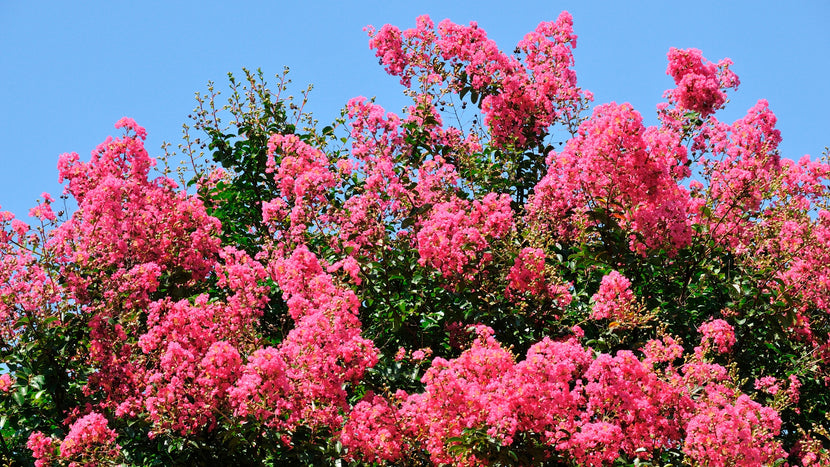How To Grow Crape Myrtles
Plant Guide

Crape Myrtles are one of the most well-loved summer bloomers around! Boasting explosions of vibrant blooms in July through to the fall, these magnificent trees and shrubs are sure to make a grand statement in your landscape.
Care for these flourishing beauties is fairly low-maintenance and well worth the time that does go into caring for them.
Ground Rules
Light
For optimal flowering, plant your Crape Myrtle Shrub in full sun, where it will not have to compete for the sun with taller trees. Long periods of shade will reduce the volume of blooms and the overall growth of your shrub. In the same way, it makes the plant vulnerable to complications such as sooty mold or powdery mildew.
Water
Although Crepe Myrtles are famously drought-tolerant, watering is still a necessity.
When establishing your plant, water it several times a week. For Crepe Myrtle Shrubs, this establishment period typically lasts several months to a year depending on the size of the shrub. Well-established plants need to be watered weekly. This is especially important in hot and dry climates.
To test if your shrub needs water, stick your finger in the soil, 2 knuckles deep, and water if the soil is dry.
Potted plants typically dry out more often. To combat this, they must be watered several times a week, or even daily. Fill the pot with water until it trickles through the drainage holes at the bottom of the pot.
Soil
The most important factor when it comes to optimal soil for your Crape Myrtle is that it is well-draining, while able to retain some moisture. Other than that, it tolerates most soil types including clay, loom, sand, acidic, or alkaline.
For outstanding results, the pH of the soil should be 5.0 to 6.5, although this acidity will not affect the color of the flowers. When planting in a pot, choose a rich, all-purpose potting mix. It should also be noted that crape myrtles are not typically invasive, so they should be spaced from other plants that will threaten their space.
Food
A common myth about Crape Myrtles is that you need to fertilize them in order to have abundant flowering. In fact, over-fertilization will promote leafy growth, which in turn will reduce the production of blossoms.
If you do opt for a fertilizer, use a general-purpose blend and spread it evenly among the base of your shrub. Similar to mulch, be sure to leave a gap between the fertilizer and the trunk of the plant. The ideal time to apply is in early spring; one annual application in plenty with established shrubs.
With younger plants, you can apply once a month throughout the spring and summer, but it is paramount that you use a much smaller amount than you would with established plants. After fertilizing, give your plants plenty of water.
For potted plants, use a slow-release fertilizer throughout the spring, but stop 2 months before temperatures are expected to reach freezing overnight.
Toxicity
Non-Toxic to Dogs, Cats, Horses and People
Mulch
To help the tree or shrub retain moisture after watering, apply a layer of organic mulch surrounding the trunk of the shrub. Leave a small gap to prevent rot.
Planting Process
- When planting your Crape Myrtle Shrub in a garden, dig a hole that is twice as wide as the root ball of the shrub; the depth of the hole should be no deeper. If your hole is too deep, suckers will more prominently form as the shrub grows.
- Fill your hole with the same soil that was removed from the hole.
- If your preferred area lacks nutrients, mix compost, or manure with the soil in the area before planting your shrub.
If you choose to plant your Crepe Myrtle in a pot, choose a container that is slightly larger than the one the plant came in. This will allow the roots to grow as the plant establishes. It is equally as important to choose a pot that has multiple drainage holes at the bottom to drain excess water and prevent root rot.
Crape Myrtles and Their Bloom Colors
| Crape Myrtle Type | Bloom Color |
|---|---|
| Dynamite Crape Myrtle Tree | Firetruck Red |
| Natchez Crape Myrtle Tree | Bridal White |
| Red Rocket Crape Myrtle Tree | Cherry Red |
| Pink Velour Crape Myrtle Tree | Bubblegum Pink |
| Ebony Glow Crape Myrtle Tree | Blush Pink |
| Purple Magic Crape Myrtle Tree | Magenta Purple |
| Muskogee Crape Myrtle Tree | Lavender-Pink |
| Dynamite Crape Myrtle Tree | Crimson Red |
| Tuscarora Crape Myrtle Tree | Coral Pink |
| Catawba Crape Myrtle Tree | Amethyst Purple |
| Twilight Magic Crape Myrtle Tree | Plum |
| Pocomoke Crape Myrtle Shrub | Rosy Pink |
| Cherry Dazzle Crape Myrtle Shrub | Berry Red |
| Plum Magic Crape Myrtle Shrub | Fuschia Pink |
| Princess Zoey Crape Myrtle Shrub | Pale Pink and Cherry Red |
| Double Feature Crape Myrtle Shrub | Wine Red |
| Coral Magic Crape Myrtle Shrub | Salmon Pink |
| Princess Lyla Crape Myrtle Shrub | Lilac Fuschia |
